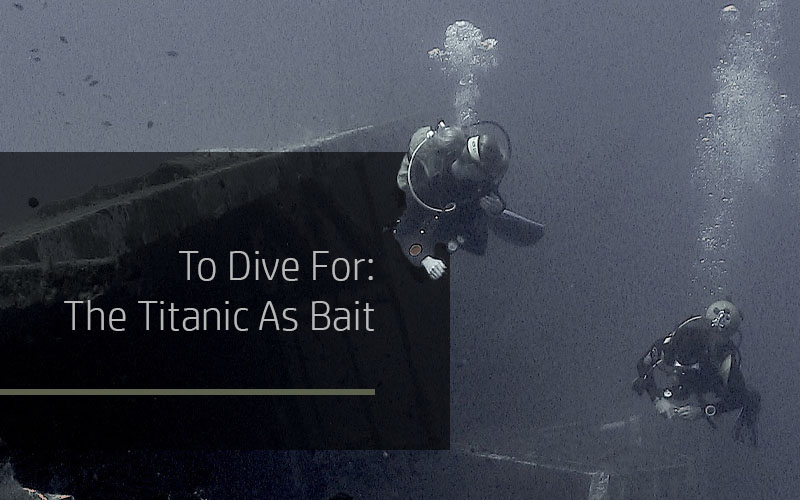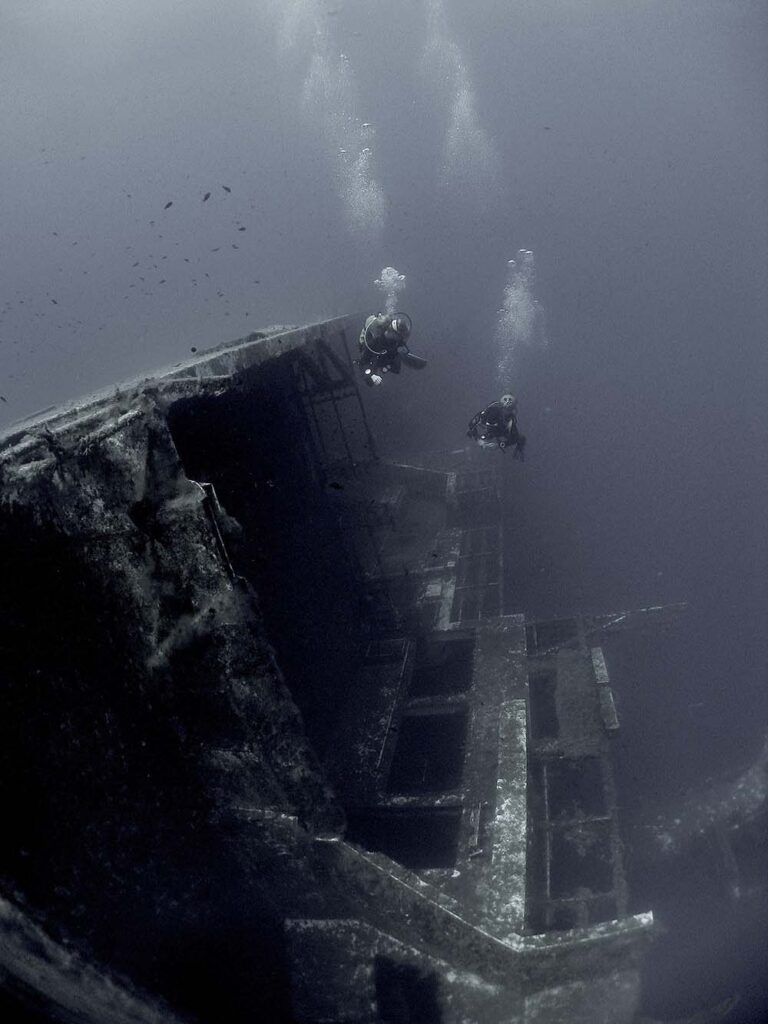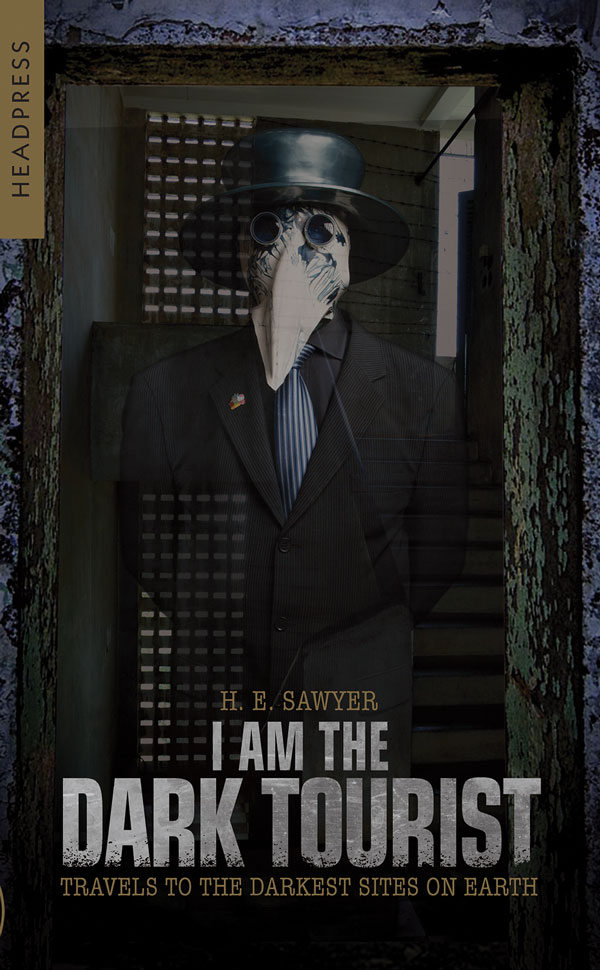
To Dive For: The Titanic As Bait
June 2023. ‘Titan Week’.
RICH TOURISTS TRAPPED in a sunken sarcophagus over two miles down on the legendry wreck of the Titanic, their air supply running out. It was a story beyond the media’s wildest dreams. They didn’t need pictures — a countdown was better than that. Our runaway imaginations would do the rest.
The truth, when it surfaced four days later, was an anti-climax. The Coastguard’s desperate search and rescue mission for the OceanGate sub became a pragmatic wreckage recovery operation, after tell-tale debris was found 500m off the iconic liner’s bow. Titan had imploded before it reached Titanic, corroborated by the Navy who had detected an acoustic crunch that coincided with the submersible’s loss of contact with the surface. Our ghoulish nature similarly dissipated with that news. Sheepishly we returned to daily life, embarrassed by our vicarious judgement of the condemned strangling one another to steal the precious air. The lingering end of asphyxiation was replaced by the sanguinity of passing before a blink of an eye, those lost already at peace before they’d contemplated their fate.
“The whole volume of a submersible collapses in about two milliseconds,” former OceanGate consultant Rob McCallum told the papers.
“And it takes 25 milliseconds for the human brain to detect a threat. It’s not so much that you die, it’s that you cease to exist. It’s almost the perfect end.”
Presumably this will be of some consolation to those bereaved by the loss of mega dark tourists Hamish Harding, Shahzada Dawood and son Suleman, pilot Paul-Henri Nargeolet, and OceanGate founder Stockton Rush. The rest of us will pick over the recriminations of a foolhardy venture with the benefit of hindsight and the “ticking time bomb” concerns from those in the know, now disseminated for public consumption by the media.[1]
Narrow Escapes
The OceanGate Incident had everything: tales of premonition, the Hitchcockian countdown, prayers for a ‘miracle’, a gung-ho blueblood maverick, and the wreck of Titanic, the most famous thing never to float.
Before the disaster diving Titanic had been effectively risk free. Discovered in 1985, the first manned trips began in 1986. The wreck’s finder Bob Ballard went. Film director James Cameron hired a Russian submersible to shoot footage on which to hang his schmaltzy love story. A tourist won a free-to-dive prize, and asked to take his girlfriend — a wish granted on the proviso they got married when their submersible reached the deck. But principally the trips focused on bringing artefacts to the surface. Perversely, those with sufficiently deep pockets to afford to visit the site would subsequently see less and less.
Until June 2023 everyone who went down signed a yadda-yadda waiver to say they didn’t suffer from claustrophobia, then did their dive and returned in one piece. The wider world had no knowledge of ‘narrow escapes’ or warnings from experts or insiders, because until the implosion the risk had not been realised. ‘Could’ and ‘might’ aren’t news. Trips to Titanic mirrored The Day Today’s ‘Pool Supervisor’ sketch: In 1986, no one died. In 1987, no one died. In 1988, no one died. In 1989 — I could go on, but you get the idea.
Yet for all those successful day return trips there was a sense of inevitability. The ocean is an alien environment. Talk of ‘respect’ for the sea is mankind being delusional, contextualising our relationship as if it were a sporting contest. In reality we face a force of nature that occupies seven tenths of the planet that can chase us screaming up the beach at Bournemouth with a gentle wave. By contrast the Indian Ocean tsunami invaded fourteen counties simultaneously and killed an estimated quarter of a million. That’s what it can do at the surface. At Titanic depth the water pressure is 6,000 pounds of pressure per square inch. When our comprehension of volume is measured by the unit of an Olympic swimming pool the pressure on Titan’s shell was equivalent to the Eiffel Tower bearing down, point first.
Titanic belongs to the sea that claimed it. Like all wrecks it now lies as bait. In 2023, five people died.
In due course there will be another manned descent. Someone will want to see what’s left of Titanic whilst there’s still time, because the currents, salt corrosion and iron-eating bacteria combined are predicted to rub it down to a dirty stain on the ocean bed within thirty years. The wreck will see me out, although I never saw the attraction of diving it anyway. You’d appreciate more detail from the 8K images filmed by OceanGate in 2022 than taking turns peering through a pint glass porthole, although that’s not ‘being there’, which is presumably why tourists pay a fortune to say it.

Complacency
Fortuitously it was never even a decision, given I neither had the means or the inclination. It was only ever famous because it sunk. But I did use what means I had to learn to dive wrecks. Paradoxically this was to overcome a fear greater than that for the sea; finding myself trapped in an armchair in later life — around about now, in fact — looking back, thinking, “if only I’d done that …”
The greatest risk in life might be not taking any risk at all, this despite the fatalities detailed in the diving magazines. We don’t die diving Titanic, but on all the other wrecks never heard of — yet they claim wreck divers in significant numbers.
Worryingly, death predominantly befalls the more experienced members of our tribe. They invariably fall victim to complacency. Because we all undertook training to mitigate the inherent risks associated with diving wrecks. We all laid a line inside an enclosed space so we could ‘escape’ when our instructor deliberately stirred the silt, rendering us blind.
Truthfully I only laid one line twenty years ago — the one required to certify me to dive wrecks. From then on I, along with every other diver I buddied up with, placed their fate in their guide. We trusted they knew the wreck like the back of their hand, and that they, like us, would not experience any debilitating cramp or panic attack while navigating its confines. Essentially we are our own worst enemy crossing our fingers just like Stockton Rush, although if our luck runs out, unlike Stockton and Co., we won’t make the news. There’ll be no statement of commiseration from The White House.
As Stockton said, there’s only one wreck everyone knows:
I read an article that said there are three words in the English language that are known throughout the planet. And that's "Coca-Cola", "God", and "Titanic".
Note
[1] The Independent — 22/7/2023 ‘Titan submersible would have collapsed in milliseconds.’ Former OceanGate consultant Rob McCallum said the blast on June 18 would have been so powerful that the crew would not even have known they were in danger. Mr McCallum worked with Mr Rush’s company OceanGate early on in the development of the project but had concerns the Titan was a “ticking time bomb.”
-
 Sale 33% OffI Am The Dark Tourist Messenger of RemembranceFrom the waters of Loch Ness to the chaos of Mexico's Dia de Muertos, H.E. Sawyer considers the questions...£14.99 - £14.99 £9.99 - £25.99
Sale 33% OffI Am The Dark Tourist Messenger of RemembranceFrom the waters of Loch Ness to the chaos of Mexico's Dia de Muertos, H.E. Sawyer considers the questions...£14.99 - £14.99 £9.99 - £25.99 -
 I Am The Dark TouristWhy would anyone want to visit sites touched by death in the first place?£9.99 - £25.00
I Am The Dark TouristWhy would anyone want to visit sites touched by death in the first place?£9.99 - £25.00
H. E. Sawyer
Like this article?
Related Posts
Comments
Copyright © Headpress

